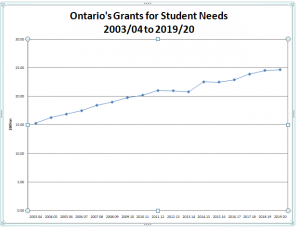In 2019/20, Ontario has experienced changes in the funding its public education system. Ontario’s Grants for Students Needs (GSN) increased slightly from $24.5 billion to $24.66 billion dollars but with significant changes in funding allocation.
Public Foundation Grant
In the Grants for Students Needs (GSN) budget, the biggest loses have been in the Public Foundation Grant which supports the salaries of teachers, early childhood educators, and other education workers. In 2019-20, the Public Foundation Grant was 5.3% lower than the 2018-19 GSN by $633 million dollars.
Learning Opportunities Grant
As part of the Learning Opportunities Grant, the Local Priorities Fund has been spent “to address a range of priorities including more special education staffing to support children in need, ‘at-risk’ students, and adult education.” The loss of this fund resulted in the loss of “about 875 full-time equivalent (FTE) teachers and about 1,600 to 1,830 FTE education workers.”
Special Education Grant
As a Special Education teacher, I am always concerned about the funding status of the Special Education Grant. Special Education funding increased by almost 3% going from $3.01 to $3.10 billion dollars. The Special Education per Pupil Amount (SEPPA) increased from $1.54 to $1.57 billion dollars. Areas of increase include the Special Equipment Amount up 12.6% from $106.6 to $120.0 million dollars. The Differentiated Special Education Needs Amount (DSENA/previously High Needs Amount) went up by 0.9% from $1.13 to $1.14 million dollars. These increased look promising but given inflation, the special education funding is just keep up. Also it is important to note that recent funding is still not addressing the increased needs of special education students in classrooms across Ontario.
Where did the lost funds go?
In 2019/20, the cuts outlined above have been used to fund the “Teacher Job Protection Funding” of $690 million dollars. “In 2019-20, the ministry is introducing a new teacher job protection funding allocation. Funding is being provided for up to four years to protect classroom teachers impacted by the proposed changes to class size and e-learning, allowing school boards to phase in these proposed changes.”
Below is my analysis of Ontario’s Grants for Students Needs between 2015-16 and 2019-20. All Grant for Students Needs data can be downloaded at the 2019/20 Education Funding, Previous Years.
Collaboratively Yours,
Deb Weston, PhD
Grants for Students Needs Analysis 2015-16 to 2019-20


I thought that education was about our kids. How can this be given that last year I had two downs students and two autistic students with little to no support. The EA allocation simply was not available. Our school has a very high needs population across all grades. I did my best but unfortunately I was put in a position where all of my skills and training as a teacher was insufficient to meet the needs of my students. This absurd situation made it impossible to move kids forward. To top it off my students will be writing EQAO assessments this year. This is a fail fail situation to say the least. My situation will be the norm if support is not provided to our students. Is this scenario what we want for our students?
Thank you for your comment. Yes, public education is about our kids but it is also publically funded through taxes. Education resources come from these taxes. Some governments see education as an investment in the future; some see it as a cost that increases taxes. Some governments prioritize smaller government expenses and increasing tax rebates to businesses to lower overall taxes. This works for people who have money but not for lower socioeconomic areas where people are just getting by. Some governments think they should encourage the opening of more private schools so they do not have to pay for these children’s educations – this also works for people who have money.
I am a great believer of supporting a strong public education system as it lifts students up and, with hard work and ability, gives them a chance to be successful in life. Ontario and Canada is known for doing this all around the world. I did not grow up in a house with resources nor did my children as I was a single mother for 6 years – so I know what it is like to scramble for milk money.
The Education Act states that it is against students’ rights to ignore barriers to education such as not providing enough support for students with special education needs. It is also a barrier to learning when teachers have to juggle the needs of many students in larger class sizes. This is exhausting and sole destroying for teachers like you and me who deeply care for the students we teach.
I encourage you to do everything you can to support students who struggle and inform communities and parents about the impact recent cuts will have on our students. The Ontario Human Rights Commission is holding hearings across Ontario to determine why students are not being adequately supported in their fundamental right to read. The commissions is looking for feedback from the public – see below
http://www.ohrc.on.ca/en/news_centre/ohrc-launches-right-read-public-inquiry
Barriers to Learning – Inclusive Education for All Students Including Those With Special Education Needs https://heartandart.ca/?p=7287
I know it’s tough teaching with little or no support but if we give up, who will stand for our students?
Collaboratively Yours
Deb Weston